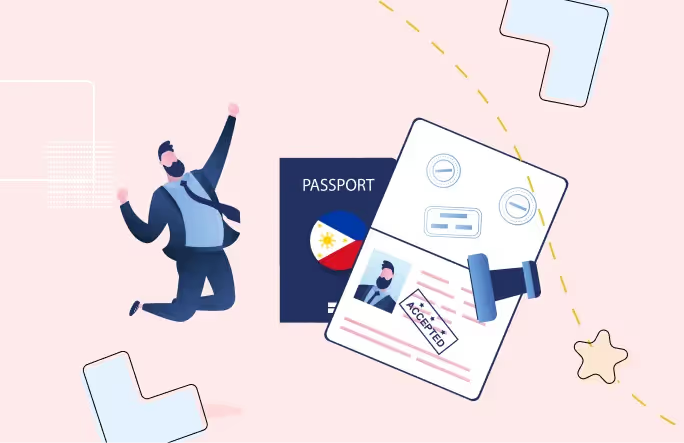Expanding your business in the Philippines or relocating your workforce demands a keen understanding of local labor laws and immigration regulations. Non-compliance with the web of Philippine laws and regulations, even if unintentional, may result in substantial penalties and fines.
To navigate this terrain successfully, it is essential to grasp the intricacies of obtaining work permits and visas, to ensure that your team members can legally reside and work within the country.
This article, will help you achieve compliance with Philippine work visas and work permits, addressing the needs of various scenarios, including:
- Hiring foreign employees in the Philippines
- Relocating current employees to the Philippines
Understanding Philippine Work Permits and Visas
Based on immigration laws, foreign nationals seeking employment in the Philippines must apply for a Philippine work visa. Moreover, they require a valid work permit. A locally licensed incorporated entity must sponsor the work permit.
Eligibility for Work Permit and Visa in the Philippines
Non-citizens and permanent residents of the Philippines, like many other nations, are required to acquire a Philippine work permit or visa. However, several occupations are exempt from this regulation, including:
- Diplomats
- Members of international organizations affiliated with the Philippines (e.g United Nations, UNESCO, International Labor Organization, etc.)
- Board members of Philippine corporations
- Owners and representatives of the Philippine Overseas Employment Administration (POEA)
- Teachers, researchers, and foreign exchange students from universities
- Temporary resident visa holders
- Employer-sponsored foreign nationals who get a Special Work Permit and work for less than six months
If applicants do not fall under this category, it is crucial to ensure that any foreign workers a company brings to the Philippines or employs locally possess the necessary work authorization and the correct visa status.
Neglecting this facet may give rise to substantial legal concerns for employers and the foreign employee in question, resulting in sanctions, administrative charges, or deportation.
{{risk-free="/components"}}
Types of Work Permits in the Philippines
There are several types of visas available to foreign nationals in the Philippines. Always keep in mind, though, that to work for your company in the Philippines, you need both a visa and a permit.
Visas and permits for individuals coming to the Philippines for business or employment purposes include the following:
Alien Employment Permit (AEP)
Foreign nationals seeking to work in the Philippines are issued an Alien Work Permit (AEP). Except for particular categories, all foreign employees must apply for an Alien Employment Permit at the DOLE Region or Field Office, according to Article 40 of the Labor Code.
The AEP is required before a foreign employee can apply for a pre-arranged employment visa (9G).
An AEP is valid for one year or until the duration of the job contract, which cannot exceed three years. However, the given AEP is only valid for the specific. A new AEP must be obtained if an employee accepts a new position within the same firm or joins a different company.
Provisional Work Permit (PWP)
A provisional work permit is issued while the foreign national's application for a pre-arranged employment 9(g) visa is being processed. It allows them to work while their visa is being processed for up to three (3) months.
Special Work Permit (SWP)
A Special Work Permit is intended for foreign nationals who are executives for companies headquartered in the Philippines or have a subsidiary in the Philippines.
Read More: Guide to hiring remote workers in the Philippines
Types of Work Visas in the Philippines
There are various types of work visas available in the Philippines; they can be categorized into short-stay and long-stay visas.
Pre-Arranged Employment Visa 9(g)
The most common type of long-stay work visa issued to foreign nationals in the Philippines is called the 9(g), often known as the pre-arranged employment visa. It allows companies in the country to hire foreign nationals who possess (high demand and short supply) skills, qualifications, and experience.
Applicants must understand that a 9(g) holder can only work for the company that sponsored their work visa. For instance, if your foreign worker's position changes, their 9(g) status is reduced to a tourist visa, and they must apply for a new work visa.
Your employee’s 9(g) visa is valid for one (1), two (2), or three (3) years and can be extended up to three (3) years at a time, depending on the length of the work agreement. However, the validity cannot exceed the specified duration in the DOLE's AEP.
Temporary Visitor’s Visa For Business Purposes 9(a)
The Temporary Visitor's Visa for Business Purposes 9(a) is the most frequent short-stay visa for foreign employees visiting the country for business, leisure, or health.
The visa can be extended every two (2) months for up to sixteen (16) months. To extend the visa beyond twenty-four (24) months, the Commissioner of the BI (Bureau of Immigration) must approve the request.
Other Types of Work Visa in the Philippines
International Treaty Trader/Investor 9(d)
This visa is issued to foreigners visiting the Philippines for business purposes in their home country. Or if they are visiting to develop and direct the operations of a business in which they have made a significant investment (at least $30,000 for individuals and $120,000 for businesses).
The Treaty Trader Visa is exclusively given to citizens of Japan, the United States, and Germany. The visa application process takes 4-6 weeks and is granted after 10–15 days. The visa is valid for 1-2 years and can be extended up to two years.
Special Non-Immigrant Visa Under E.O. 226
This visa is granted to foreign nationals with regional operating headquarters. The Special Non-Immigrant Visa under Executive Order 226 is valid for three years and can be extended for an additional three years.
Applying for a Philippine Work Permit and Work Visa
Before applying for a work visa, your employee must obtain a work permit. The application process to obtain a Philippine work
permit is as follows:
Applying for an Alien Employment Permit (AEP)
Start by completing an AEP application for your employee, which is available on the DOLE website. This application can be filed by the employer or by an individual based on the case. The requirements along with their application:
- Notarized employment contract
- Application form
- Passport copy
- Two (2) 2x2 ID Photo
- Business documents
- Tax Identification Number from BIR (BIR Form 1904 or 1902) or copy of E-TIN registration
- Certified true copy of valid Mayor's Permit from BPLO
- Certified true copy per page of SEC registration and General Information Sheet (GIS) from SEC
- Certified true copy of the Certificate of Business Name Registration in case of sole proprietorships from DTI
- Proof of publication of the job vacancies in a newspaper of general circulation together with a duly notarized affidavit
You may see the full list of requirement here. Once the AEP is approved, the applicant’s name will appear in a newspaper.
Those exempt from the AEP requirement must get a certificate of exclusion from their local DOLE office. The applicant will most likely need a Philippine Alien Certificate of Registration (ACR I-Card), which involves biometric data.
Applying for a Pre-arranged Employment Visa 9(g)
Once your employee has completed the AEP application. The next step is to apply for a 9(g) visa through the Bureau of Immigration. The application requires the following documents:
- Notarized certification of foreign and Filipino employees
- Application form (FA Form No. 2);
- Medical and physical examination report (FA Form No. 11) issued by an authorized physician
- Employment contract
- Four (4) passport-sized photos
- Police clearance
- Photocopy of Securities and Exchange Commission (SEC) certification, and Articles of Incorporation (AOI)
- A certified true copy of AEP from DOLE
- BI clearance certificate
Wait for your employee’s application to be approved. However, in cases where your employee has to start employment before the 9(g) is granted and while the AEP is awaited, the Bureau of Immigration may issue a three-month Provisional Work Permit. This must be filed as soon as the employee files the AEP application, and the Bureau of Immigration will provide it within two weeks.
Read More: Cost of an employee vs. cost of a contractor
Philippine Work Visa Processing Times
The waiting period for acquiring an AEP is at least one to three weeks. On the other hand, obtaining a 9(g) work visa can take two (2) to three (3) months. As a result, you must carefully organize your employees' applications and entry into the country promptly.
Cost of a Philippine Work Permit and Visa
Philippine work permit - with a validity period of one year - costs nine thousand pesos (P9,000.00). If the duration of work exceeds one year, an extra four thousand pesos (P4,000.00) will be levied for each additional year or part thereof.
Employer Obligations for Work Permits and Visas
It is the employer's responsibility to ensure that all documentation complies with Philippine laws and regulations. Any mistakes might invite troubles associated with non-compliance.
- Employment Contract: This is the most important document you must produce before hiring foreign employees in the Philippines.
- Visa Sponsorship Documents: Employers who sponsor overseas employees or Philippine immigrants must present a letter of invitation and accompanying evidence for visa applications.
- Compliance with Labor Laws: Employers must comply with Philippine labor laws, such as minimum pay, working hours, and other employment rules. Failure to do so may result in penalties and legal action.
- Reporting Obligations: Employers are also required to report the employment of foreign nationals to the Bureau of Immigration (BI) and other relevant government agencies. They need to submit regular reports and updates regarding the status of their foreign employees.
- Record-Keeping: Employers must keep correct records of their foreign employees' employment contracts, visa status, and relevant papers. Government officials may inspect these records.
- Social Security and Benefits: Employers must remit social security contributions to the Social Security System (SSS) on behalf of their employees. In addition to social security obligations, employers and employees must contribute to the Philippine Health Insurance Corporation (PHIC) and the Home Development Mutual Fund (HDMF). Foreign employees need not pay contributions to the HDMF.
If you have an employee relocating to the Philippines and wish to retain them, consider using an Employer of Record (EOR) service like Gloroots. With Gloroots' EOR services, you can onboard your employees in their new location and also facilitate the process of obtaining work permits and visas all while ensuring compliance in every step.
Streamline Employee Work Permits and Visas in the Philippines with Gloroots
Working together with Gloroots provides you access to its expertise that will resolve the tedious and complicated visa and permit projects end to end.
- We can help you with each step of the visa and work permit acquisition. Our hassle-free, streamlined, and transparent visa acquisition procedure leaves no space for errors and provides sure-shot compliance compared to traditional visa and immigration services.
- We prioritize risk management by guiding clients through the ins and outs of Philippine labor and immigration requirements to eliminate any unforeseen trouble.
- Our Employer of Record offers a comprehensive platform for international hiring, including payroll, visa and immigration assistance, background checks, workplace access, equity management, and contractor recruitment
Gloroots will handle the applications and permits from the start and keep you updated on the progress.
Philippine Work Permit and Visa FAQs
1) What is an Alien Employment Permit (AEP)?
Individuals from outside the Philippines who want to work in the Philippines officially are given an AEP. If Filipino companies can't find anyone who can do the job, they can give it to someone else. An AEP is usually the first thing you need to get into the country, live, and work there. You may also need other visas.
2) Can my employee’s 9(g) visa be renewed?
Yes, the visa can be renewed several times.
3) Do I need to apply for both an Alien Employment Permit (AEP) and a Provisional Work Permit (PWP)?
As soon as you apply for an AEP, you need to apply for a Provisional Work Permit if you want your employee to start immediately while you wait for your pre-arranged work visa or 9(g) visa.
4) What’s the difference between a Special Working Permit (SWP) and a Provisional Work Permit in the Philippines?
A special work permit is a work permit for foreign nationals willing to work in the Philippines for six months. The position applied should also be temporary. On the other hand, a Provisional Work Permit (PWP) is issued to foreign nationals who are in the process of applying for a pre-arranged employment visa or a 9g visa.
5) Are family members included in work visa applications in the Philippines?
If the DOLE gives a foreigner an AEP, they can apply for dependent visas for their partner and children under 21 who are not married. Family members will need to apply for dependent status independently and get approval from the DOLE.
6) Are dependents allowed to work in the Philippines?
Dependents aren’t allowed to work in the country. However, it is possible to get a Special Work Permit.

.webp)




























.webp)


























.webp)


.webp)


.webp)












